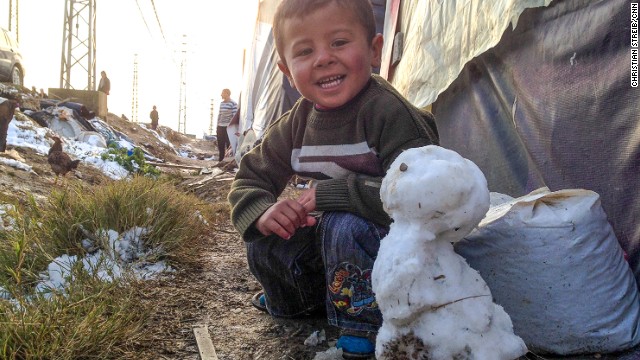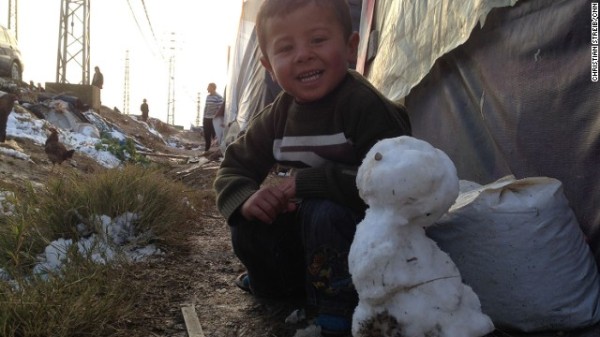
Refugees threatened by winter weather
STORY HIGHLIGHTS
- Winter storm “Alexa” has brought snow and rain to Lebanon’s Bekaa Valley
- Region is home to thousands of people who have fled the civil war in Syria
- One out of every four people living in Lebanon is now a Syrian refugee
- Many are living in makeshift camps, with little but flimsy tents to keep out the cold
Syrian refugees in Lebanon’s Bekaa Valley thought life couldn’t get much harsher. But that was before winter storm “Alexa” moved in. The rain and snow have since made things even more miserable.
Scenes of despair are all around: One young girl, sockless and in slippers, trudges through the snow gathering what’s left of it for water. Later, she’ll need it to cook with.
Across the road, huddling close to the makeshift tents that will barely keep out the rain, let alone protect them from the cold, three teenage boys describe the appalling conditions they’re living in.
“There’s nothing for us to get warm with,” Ahmed tells me. He’s from Homs and is wearing nothing more substantial than a hoodie.
His friend Abdullah, also from Homs, adds: “We need heating appliances. We need winter clothes for the kids. The adults can take the cold, but the kids can’t,” he said.
Aid workers have been quick to mobilize, fanning out across the hardest hit areas in Lebanon.
According to the UN’s Refugee Agency (UNHCR), the Lebanese Armed Forces, the UNHCR and their partner NGOs have been able to speed up the distribution of additional emergency shelter kits – including plastic sheets, timber and tools – to thousands of refugees living in tents in the Bekaa, eastern Lebanon, so far the region most affected by the storm.
The U.N. says that they too are being hampered by the poor conditions. Emergency teams are dealing with blocked roads, and they say, alternate shelters are being prepared.
“For the hundreds of thousands of refugees in Lebanon, as well as those in neighboring countries and the displaced in Syria, a storm like this creates immense additional hardship and suffering,” said Amin Awad, UNHCR‘s Middle East and North Africa bureau director. “With Lebanon’s help, we’re doing everything we can to get rapid additional help to people who most need it.”
But the refugees in this particular makeshift camp in the Bekaa tell me help hasn’t come fast enough. They say they’re still waiting.
Close by, adults chop any firewood they can as children, many of them with nothing but slippers on their feet, try to distract themselves from the cold.
Some, like sister and brother Khadija and Amjad, from Aleppo, crave the remnants of a childhood long forgotten; they make the most of the frosty conditions by building a snowman.
For others though, the needs are more basic: they seek warmth and food.
According to the UNHCR, Lebanon is the largest Syrian refugee-hosting country in the region, with 838,189 Syrian refugees either registered as refugees or awaiting registration.
So, that means that the country of Lebanon, with a population of just over 4 million, has now grown to over 5 million people due to the growing number of refugees. And, that number is climbing.
The UNHCR says that, unlike other countries neighboring Syria, there are no established refugee camps. Instead people are living in the community in nearly 1,600 different areas.
Indeed, one of the biggest problems faced by Syrians who’ve escaped the war at home and come to neighboring Lebanon is that the Lebanese government won’t allow for the construction of official refugee camps.
Despite continued requests from aid organizations, Lebanese political leaders are too fearful that camps for Syrians will become permanent, just as camps for Palestinian refugees, who began escaping to Lebanon in 1948, did.
As the sun begins to set over the ramshackle tents, more fear is setting in. One of the worst winters on record has only just begun. For these desperate souls, the night ahead will be darker and colder than ever.



Leave a reply